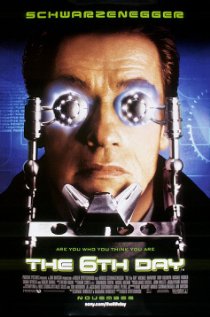

Synopsis: In this sci-fi action picture, helicopter charter pilot Adam Gibson (Arnold Schwarzenegger) and his partner Hank Morgan (Michael Rapaport) stumble into a scheme by corporate magnate Michael Drucker (Tony Goldwyn) and his henchmen to take over the world with clones, in part through expensive political lobbying. Drucker uses cloning technology to provide a stable, loyal workforce, but it is hard to say anything nice about his views on employee retirement. Arnold Scharzenegger plays both Adam Gibson and the clone of Adam Gibson, who eventually cooperate to rescue his family and sow mayhem among the bad guys. We see car chases, gunfights, exploding helicopters, hand-to-hand fighting, and bad guys falling through skylights into a spacious atrium. Labs that grow clones are equipped with giant fluid-filled tanks topped with catwalks that feature glass walls for some fairly predictable but always enjoyable action in the climax. Get a big bowl of popcorn and put your brain on ice for this one.
 |
 |
 |
 |
 |
Cloning: The plot relies on the ability of Michael Drucker, the chief bad guy in the film, to replace people almost immediately with clones. The writers of this film understand that everybody knows that it takes nine months to make a baby, let alone a full-grown adult human, so they have invented a process in which people (pets, too) can be replaced in a matter of hours from pre-grown "blanks." The cloning process is complete when the individual's DNA is used to "finish" the blank. We see this process on screen, as embryo-like blanks in growth tanks take on the features of the person to be cloned.
Scientific accuracy: No attempt here. The human genome has genes required for development. Variation in these genes causes people, other than identical twins, to look different from each other. The film is not clear whether the blanks are grown without DNA, which is ridiculous, or with generic DNA that is customized at the last minute, which is almost as ridiculous. Some science words are thrown around in this matter to create an atmosphere, but there really is no science here.
Inherited Disease: Cloned people working for Michael Drucker, the film's bad guy, have been modified with inherited disorders to limit their lifespan. That way, if they aren't team players, they will be allowed to expire. An expensive cloned football quarterback has been engineered to have a predisposition to liver cancer. A key scientist's cloned wife has been given cystic fibrosis.
Scientific accuracy: This is one tiny bit of scientific accuracy in this film. The writers have picked a couple of inherited conditions that would shorten lifespan, even if the symptoms of cystic fibrosis are not accurately depicted.
Memory transfer: What is the use of having a clone replace you if they don't have your memories? The writers of the film solve this problem through a technology that allows everything that a person knows to be copied in seconds by shining a pair of lights into their eyes. In a second or two, there is an up-to-the-minute version of that person's memories. The complete contents of a human brain fit on a small computer disc. Even better, the disc can be popped into a player, and everything that the person saw recently can be replayed on a screen. All that is needed to copy a person is to transfer their memories to a blank that has been primed with their DNA.
Scientific accuracy: Where do we start here? The exact nature of our memories has not yet been fully explained, but it is clear that the entire contents of our brains cannot be extracted through our eyes in a couple of seconds. Whatever the nature of our visual memories, they are not likely to resemble digital video that can be replayed on any computer.
The storage capacity of the human brain has been estimated to be around 2.5 petabytes (2.5 million gigabytes). Anyone who has ever purchased a two-DVD set knows that a DVD only holds about two hours of video. A DVD holds 4.7 gigabytes, so if the human brain encoded video like a DVD, it would take over 500,000 DVDs to hold the capacity of the human brain. We are willing to grant that there might have been significant advances in storage technology in the years leading up to the future in which the film is set, but it would take almost twenty doublings of storage capacity (about forty years from now, using Moore's Law as our clock) to reach this capacity. It is hard to believe that the film is set in 2052, because many aspects of daily life (cars, homes, shopping malls, consumer goods, and fashion) look pretty much like they did in 2000, when the film was made.
DNA display: Dr. Griffin Weir (Robert Duvall) is seen seated in front of a computer display, searching for the defect that killed the cloned replacement for his deceased wife. Predictably, the display shows a space-filling model of DNA, turning as if it is on a rotisserie. It looks like about 30 base pairs.
Scientific accuracy: Good displays for large amounts of genomic data were in wide use in 2000. We can only assume that the filmmakers decided that the audience for this film can't understand the difference between a display that shows the structure of DNA and a display that shows DNA's information content efficiently.
Summary: A few seconds of screen time devoted to inherited disorders can't save this film from a one-flask rating.
 |
 |
 |
 |
 |
Rights of clones and the law. There isn't much room for talk in this action picture, so they make this discussion easy. The film opens with a montage of real events: the cloning of a sheep (1997) and the mapping of the human genome (2000). It then postulates anti-cloning demonstrations, and a spectacular failure of some kind in a human cloning experiment leading to the destruction of the clone. We learn later in the film that the cloning experiment failed because the human mind is too big to transfer over to the clone. The clone being discussed here is born of the fantasy cloning of the film, where clones are born as adults, with memories harvested from recently-deceased individuals.
As a consequence, there is a Sixth Day law that prohibits the cloning of a human being. There is a mandatory 40-year minimum sentence for participating in cloning a human being. Cloned humans are not persons under the law, cannot own property, and will be killed if they are discovered. Michael Drucker, head of Replacement Tech and its veterinary arm RePet, is convinced that he can manipulate or buy off enough politicians to get the law changed eventually. Good for him, because he himself is a clone and would be destroyed under the laws in place in the film's time period.
We see scenes of demonstrators in front of RePet and Replacement Technologies (which nominally grows replacement organs but also grows complete human clones). The demonstrators are portrayed as anti-cloning religious fundamentalists. The argument, repeated several times by various characters, is that clones have no soul, and that cloning to defeat death is opposition to the will of God. One character takes this seriously enough to be engaged in a campaign to personally kill Drucker and several other people at the beginning of the film.
Absent from the debate between greedy corporate clones and murderous religious fundamentalists are any people with views that are at least two-dimensional.
Religion vs. science. Religion, in this film, seems to be an acceptance of fate. Science is the handmaiden of brutal corporate monsters like Drucker, who deliberately builds in genetic flaws to make his people renew their contracts with him on favorable terms.
Adam Gibson confronts Drucker, who brags about defeating death. Adam asks, "Who gets to decide who lives and who dies, you?"
Drucker asks, "You have a better idea?"
Adam says, "Yeah. What about God?"
Drucker dismisses Adam as "one of those" before arguing that if God made man in his own image, then he gave him the power to reason, to explore, to discover. He says that he's just taking over where God left off. Adam has no answer for this other than to make an anatomical suggestion that is impossible unless Drucker and his clone can be together. Strangely, the religious fundamentalists that help to drive the film's plot don't object to life-saving medical procedures short of cloning, or to a pervasive vapid consumerism that makes people buy Sim Pals (creepy dolls that seem to have living parts) and ever-friendly holographic girlfriends.
Knowing your genetic fate. There is a memorable scene near the end of the movie, as the cloned Adam Gibson makes his way through the clone-growing laboratory, destroying it. He comes face-to-face with the recently (and incompletely) re-cloned Michael Drucker, ever the deal-maker. While staring down the barrel of Adam's massive laser pistol, Drucker explains, "We put congenital defects into the clone DNA to give the clones short lifespans. Want to know what you're going to die of? How long you've got to live? You can go right upstairs, right now, and look it up."
This brings us to the moment explored in a more sensitive way in many other films with genetic themes. A person at risk for a life-threatening inherited disorder is given the opportunity to give informed consent to receive information that, once learned, cannot be forgotten.
This being an action picture, Adam Gibson reflects on his choice for a moment, then proceeds to lay waste to the glass-walled mezzanine housing the computers with his genetic data with a volley of well-placed laser shots. Predictably, the computers blow up in showers of sparks amid the glass fragments. That's the way that Arnold Schwarzenegger refuses to sign a consent form!
Authenticity and identity as a clone. Dr. Weir's cloned wife is dying, and makes him promise not to bring her back as a clone. She is apparently having difficulty with her identity, and says, "Catherine died five years ago. The feelings that I have aren't mine, they're hers."
One of Drucker's hired killers, Wiley (Rodney Rowland) complains that while he's been killed and brought back twice in two hours, he feels cheated, saying, "No white light, no angels, nothing!"
When the cloned Adam Gibson learns that he is a clone, another of Drucker's oft-cloned hired killers, Talia (Sarah Wynter) asks, "Kind of takes the fun out of being alive, doesn't it?"
At the end of the film, the cloned Adam Gibson asks whether he is human, whether he has a soul. The original Adam Gibson points out that he was willing to die to save his family, and, "If that's not being human, I don't know what is."
People with transplanted organs or even knee and hip replacements sometimes have some difficulty with their identity upon recovery. This film makes us think about what is our essential to our identity and humanity, but not very much.
Summary. This film raises a few ethical issues in a light way in the quiet spaces between action sequences. These have a little more merit than the terrible science, earning the film a rating of two hearts.